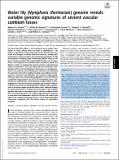Water lily ( Nymphaea thermarum ) genome reveals variable genomic signatures of ancient vascular cambium losses
Author(s)
Povilus, Rebecca A; DaCosta, Jeffrey M; Grassa, Christopher; Satyaki, Prasad R.V.; Moeglein, Morgan; Jaenisch, Johan; Xi, Zhenxiang; Mathews, Sarah; Gehring, Mary; Davis, Charles C; Friedman, William E; ... Show more Show less
DownloadPublished version (2.120Mb)
Publisher Policy
Publisher Policy
Article is made available in accordance with the publisher's policy and may be subject to US copyright law. Please refer to the publisher's site for terms of use.
Terms of use
Metadata
Show full item recordAbstract
© 2020 National Academy of Sciences. All rights reserved. For more than 225 million y, all seed plants were woody trees, shrubs, or vines. Shortly after the origin of angiosperms ∼140 million y ago (MYA), the Nymphaeales (water lilies) became one of the first lineages to deviate from their ancestral, woody habit by losing the vascular cambium, the meristematic population of cells that produces secondary xylem (wood) and phloem. Many of the genes and gene families that regulate differentiation of secondary tissues also regulate the differentiation of primary xylem and phloem, which are produced by apical meristems and retained in nearly all seed plants. Here, we sequenced and assembled a draft genome of the water lily Nymphaea thermarum, an emerging system for the study of early flowering plant evolution, and compared it to genomes from other cambium-bearing and cambium-less lineages (e.g., monocots and Nelumbo). This revealed lineage-specific patterns of gene loss and divergence. Nymphaea is characterized by a significant contraction of the HD-ZIP III transcription factors, specifically loss of REVOLUTA, which influences cambial activity in other angiosperms. We also found the Nymphaea and monocot copies of cambium-associated CLE signaling peptides display unique substitutions at otherwise highly conserved amino acids. Nelumbo displays no obvious divergence in cambium-associated genes. The divergent genomic signatures of convergent loss of vascular cambium reveals that even pleiotropic genes can exhibit unique divergence patterns in association with independent events of trait loss. Our results shed light on the evolution of herbaceousness-one of the key biological innovations associated with the earliest phases of angiosperm evolution.
Date issued
2020Department
Whitehead Institute for Biomedical Research; Massachusetts Institute of Technology. Department of BiologyJournal
Proceedings of the National Academy of Sciences of the United States of America
Publisher
Proceedings of the National Academy of Sciences